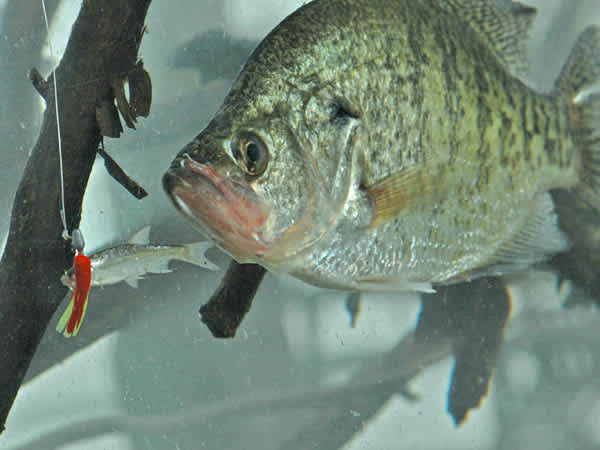Fishing for Big Crappie Using Goldfish
John E. Phillips 07.19.12

In less than 30 seconds, my quill sank. I brought a 1-1/2 pound crappie over the gunwales of my boat. For the next 20 minutes, I continued to take crappie. Although the minnows-in-a-glass-jar idea of my uncle’s was strange, I realized that renegade tactics could produce crappie when no other methods of fishing would. From that early boyhood experience, I started looking for renegades in the sport of crappie fishing – both men and women who broke with traditional tactics and utilized off-the-wall strategies to consistently catch crappie. I wanted to find those unusual individuals who used creative alternatives to take crappie.
Two of the strangest techniques I’ve ever seen for catching crappie I learned from Paul Johnson and Vernon Green, Sr. of Oklahoma. “We believe we catch bigger crappie on goldfish than we do on minnows,” Johnson reported. “The goldfish seem to live longer than minnows,” Green explained. “I also think crappie can see them easier than they can minnows.” These two anglers utilize quart bleach bottles with pieces of monofilament tied to the necks of the bleach bottles, shot leads attached to the line 2 to 4 feet below the surface and crappie hooks baited with goldfish on them. The jugs troll the goldfish across spawning bays where crappie hold during the spawn. Another method these anglers have used successfully is to allow their jugs to troll 1/24 or 1/32 ounce jigs instead of minnows. The jugs troll the jigs in the area where the crappie are holding, and the fishermen can have more baits in the water than if they cast and retrieve or troll rods out the backs of their boats.
“Yet another method we use is bush hooks for crappie when they’re on the bank spawning,” Johnson said. “We tie 6 pound test line on the ends of green bushes that hang out over the water and attach 1/24 or 1/32 ounce jigs to the ends of the lines hanging down in the water. We put our jigs from 6 inches to 2 feet below the surface. The trick to catching crappie using bush hooks is to fish on windy days. When the wind blows, the bush moves, which causes the jig to move and have a lifelike appearance. When the crappie see the jigs moving next to the bank, they’ll come in and take the jigs. The bushes set the hooks for you. Jug fishing and bush-hook fishing are ways we catch catfish that also produce crappie in the spring when they’re in shallow water and moving into spawning bays and coves. Before you utilize live goldfish, jugs or bush hooks for your crappie fishing, check your local fisheries regulations. These tactics are not permitted in all states for the taking of crappie.
 Killing the Cork:
Killing the Cork:
The weather was cold. The temperature had dropped 20 degrees overnight. I was convinced crappie were not going to bite. But my fishing partner said, “Cast this 1/24 ounce jig out to the sunken treetops, and let the cork sit still. After I watched my cork for about 1-1/2 minutes, the cork sank. I set the hook and reeled in a 1-1/2 pound crappie. When I asked Padgett why a crappie would hit when the cork was still, he explained that, “Even when you’re not retrieving the cork and causing the jig to move, the jig will have a lifelike appearance. When the cork appears to be sitting still in the water, the jig below it will be moving slightly due to the current under the water. This dead-cork tactic suspends a jig in a place where the crappie hold and means the crappie must exert little effort to inhale the jig.”
For more tips, tricks and unorthodox methods for catching crappie, check out my article on fishing for crappie in 100 degree heat.
To learn more about successful crappie fishing year-round, buy John E. Phillips’ book, “The Masters’ Secret of Crappie Fishing,” by going to www.nighthawkpublications.com/fishing/masterscrappie.htm.


